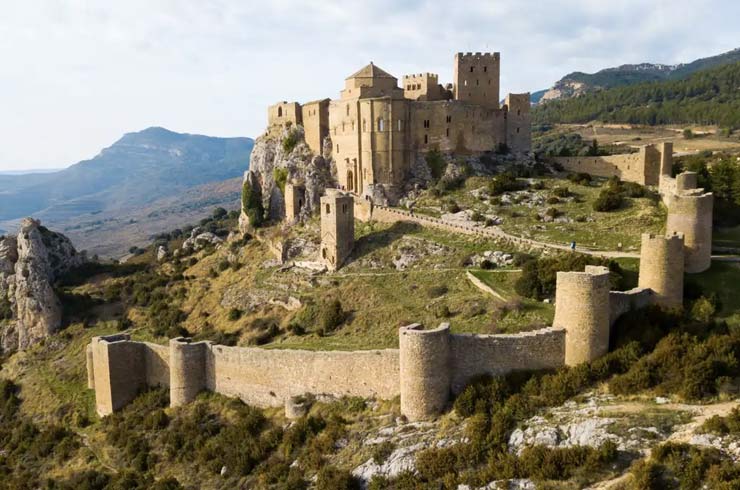Majestic, centuries-old, and steeped in history, Loarre Castle is not only a gem of European Romanesque heritage—it’s a window to the past that continues to move everyone who visits.
Get to know Loarre Castle in depth through this article: its history, architecture, how to visit, what to see, and why experiencing it with Rutica41 can make your trip truly special.
Walking its stone corridors, gazing up at its age-old towers, or taking in the endless views over the Hoya de Huesca is only part of the journey.
This blog is designed to guide you through a complete experience: from how to get there and what to expect, to practical tips and the added value of going with an expert guide.
Get ready to explore one of the most impressive castles in Spain.
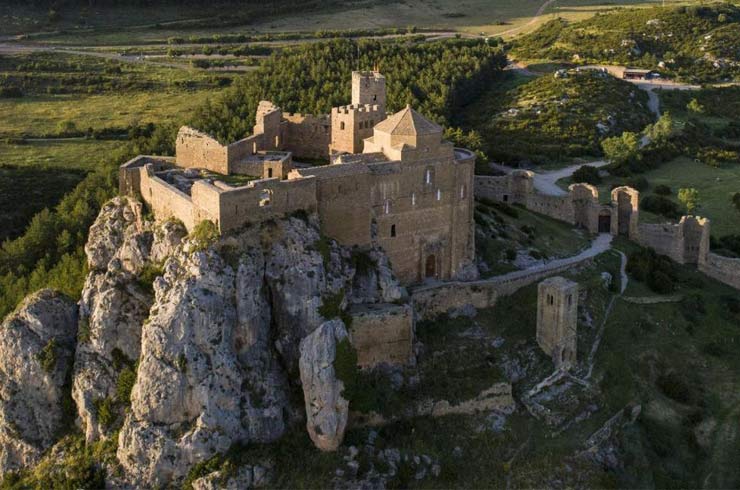
Where is Loarre Castle and how do you get there?
A strategic fortress at the foot of the Pyrenees
Loarre Castle lies in the north of the province of Huesca, in the autonomous community of Aragon, within the municipality of Loarre.
This formidable complex rises 1,071 meters above sea level on a limestone hill, dominating the landscape of the Hoya de Huesca and offering one of the most spectacular viewpoints over Aragon’s Pre-Pyrenees.
Its location was no accident: the fortress was built as a defensive stronghold during the Christian expansion southward in the 11th century.
From its towers, guards controlled the access routes from the plain to the mountain passes, including the roads toward Bolea, Riglos, and Arguis.
How to get there from Zaragoza, Huesca, and other cities
If you plan to visit Loarre Castle, the first step is knowing how to reach this hidden treasure. From Zaragoza, the drive takes roughly 1 hour and 30 minutes via the A-23 motorway toward Huesca, then connecting with the A-132 toward Ayerbe and Loarre.
From the city of Huesca, access is even more direct: it’s about 35 kilometers, roughly a 40-minute drive.
The castle has free parking nearby.
Although public transport is limited and involves impractical connections, at Rutica41 we offer organized excursions from Zaragoza, with transportation, tickets, and a guide included so you can enjoy the experience without any hassle.
For travelers who want to make the most of their time and skip the logistics, these guided experiences are the most comfortable and rewarding way to explore Loarre.
Also check our departures from Zaragoza page, where you’ll find all the tours we run from the city—including those that take you to unique places like Loarre Castle.
🚗 Planning a longer trip around Aragon? Don’t miss our guide to the best day trips from Zaragoza—including medieval towns, dramatic landscapes, and foodie stops.
Architecture and standout features of Loarre Castle
A jewel of European Romanesque art
Come and get to know Loarre Castle with us—step into one of the purest and best-preserved examples of Romanesque art in Europe.
The castle perfectly combines military and devotional functions, something you’ll notice in every corner.
Built from limestone and seamlessly integrated into the rocky outcrop, it impresses not only with its solidity but also with its architectural beauty.
Even from afar, its unmistakable silhouette captivates: massive walls that seem to rise from the mountain and a curtain wall embracing the complex as if still guarding the secrets hidden within.
We’ll guide you through each of these spaces, helping you understand the defensive logic and symbolic meaning behind its layout.
Towers, walls, and defensive systems
One of Loarre’s most fascinating aspects is its defensive system.
You’ll enter through the main gate, which leads to the walled enclosure reinforced with semicircular towers.
Inside, the Keep (Torre del Homenaje) and the Queen’s Tower (Torre de la Reina) stand out—both designed to watch over and protect the approach from the plains. From their heights, the views across the Hoya de Huesca are simply breathtaking.
We’ll show you how every corridor, every spiral staircase, and each narrow passage served a purpose: resisting assaults, hindering enemy access, and enabling defense from within.
We’ll also explore features that reveal everyday life for those who inhabited this place centuries ago.
The Church of San Pedro and the Crypt of Santa Quiteria
At the heart of the castle stands the Church of San Pedro, a basilica-plan building with three naves and an impressive dome.
It’s one of the spaces that most surprises our visitors—both for its monumentality and for the light filtering through its Romanesque windows.
We’ll also descend to the Crypt of Santa Quiteria, a semicircular space carved into the rock that served as a site for burials and prayer.
Its atmosphere transports us straight back to the 11th century—a silent corner where the stones still seem to whisper the prayers of the Augustinian monks.
Experience a guided day trip to the majestic Loarre Castle, one of Aragon’s historic gems. View Tour
Artistic and symbolic details
Decorative elements abound to enrich your visit: historiated capitals, carved columns, barrel vaults, and perfectly traced arches.
We’ll explain the symbolism behind many of these motifs and how Romanesque architecture spoke of faith, power, and eternity.
In every guided visit with Rutica41, we pause over these details so you understand that Loarre is not only a fortress, but also a living work of art.
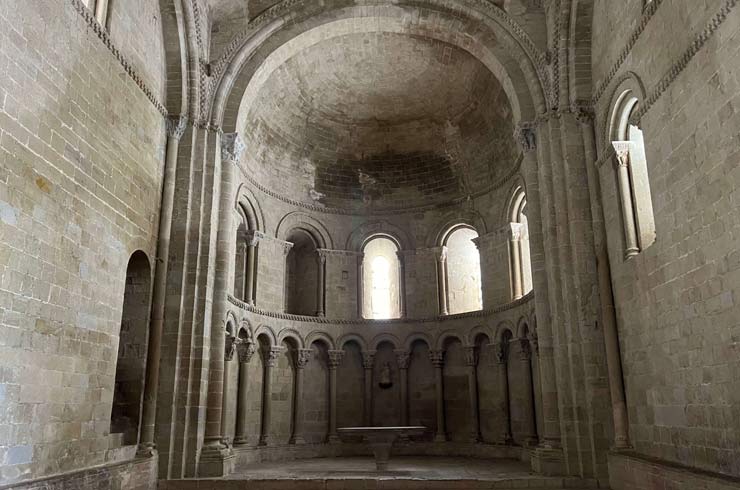
Unmissable sights and experiences at Loarre Castle
A visit that awakens the senses
We invite you to explore one of Aragon’s most awe-inspiring places. Get to know Loarre Castle with us and see how we experience it—not just as a cultural visit, but as a truly sensory journey.
From the moment you arrive, the crisp air, the majestic silence of the surroundings, and the powerful silhouette of the fortress draw you in.
It’s full immersion in history—but also in nature and emotion.
🌿 Love culture and local products? Continue your journey with the Belchite region: olive groves & olive-oil experiences, a perfect pairing with your Loarre Castle visit.
Suggested route through the castle interior
On our visits, we usually start at the main entrance, crossing the fortified gate and walking alongside the sturdy walls that guard the interior.
We continue to the parade ground, a broad open space from which the various paths branch toward the most notable rooms.
Together we explore the Church of San Pedro, the crypt, the guardhouse, the passageways, and the towers—giving you time to take in each space calmly and in depth.
We climb to the highest viewpoints so you can enjoy a unique panorama of the Hoya de Huesca, with mountains on the horizon and fields stretching out like a tapestry.
Nooks with history (and legend)
Every corner of the castle holds a story worth telling.
We pause in the lesser-known spaces—the ones that often go unnoticed but are steeped in legends of kings, monks, and knights, as well as cinematic moments that left their mark.
Did you know Loarre Castle has been a filming location for movies like Kingdom of Heaven by Ridley Scott and the series El Ministerio del Tiempo?
We share behind-the-scenes curiosities and point out the exact spots where iconic scenes were shot.
Experience a guided day trip to the majestic Loarre Castle, one of Aragon’s historic gems. View Tour
A living experience, not a museum
Loarre isn’t a castle frozen in time.
It’s a living place, where echoes of history mingle with the murmur of the wind between the stones.
That’s why every visit is different: it changes with the season, the light of day, and each traveler’s perspective.
And we’re there to help you connect with this place emotionally, historically, and aesthetically.
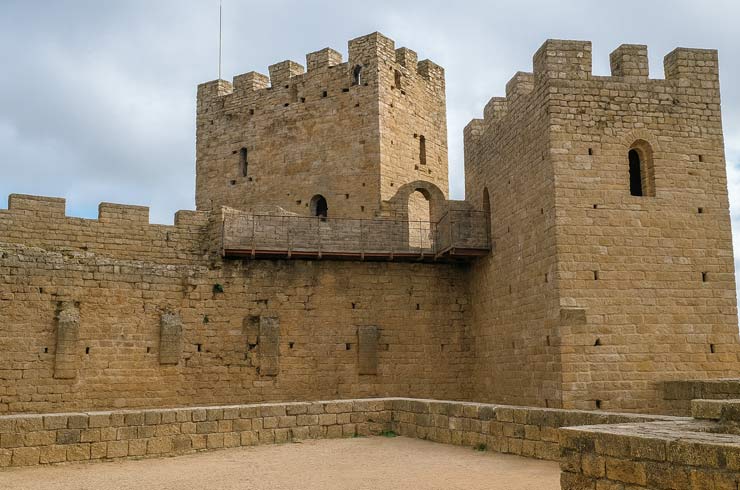
Beyond the walls: curiosities and secrets of Loarre Castle
A frontier jewel in Aragon’s history
Loarre Castle was anything but an ordinary construction.
It became the launch point for the Kingdom of Aragon’s ambitious expansion southward.
Sancho III “the Great” ordered it built as a watchtower and control bastion over the Hoya de Huesca plain, then under Muslim rule.
Later, his son Sancho Ramírez turned it into a palatial and religious fortress.
According to the chronicles, decisive military campaigns were planned here, and clerics living in community were housed within its walls.
For decades, Loarre stood as a symbol of Aragon’s rising power, long before its union with Castile.
Romanesque architecture with unique solutions
One of the castle’s most striking features is the dome of the Church of San Pedro.
It’s a hemispherical dome set on a cylindrical drum—a rarity in Iberian Romanesque—that shows Lombard Romanesque influences.
Also noteworthy are the barrel vaults, semicircular arches, and capitals decorated with vegetal motifs and human figures.
What’s more, much of the construction was carried out without mortar, that is, without binding material between the stones.
The precise fit of its ashlars has allowed many parts of the castle to stand for over a thousand years.
The castle on film and television
Thanks to its extraordinary state of preservation and its natural setting—free from modern visual intrusions—Loarre Castle has served as a location for multiple screen productions.
The best known is Kingdom of Heaven (2005), directed by Ridley Scott, in which the castle stood in for Crusader fortresses in the Holy Land.
The production involved partial closure of the monument and greatly boosted its international fame.
It also featured in Valentina (1982), directed by Antonio José Betancor, and appeared in episodes of the cult series El Ministerio del Tiempo (2015–2020), bringing it to new generations of viewers.
Legends, tunnels, and mystery
Like any self-respecting medieval castle, Loarre has its legends.
One of the most popular speaks of an underground passage connecting it with the nearby collegiate church of Bolea—supposedly used for secret escapes or the transport of relics.
Although no physical evidence has ever been found, the myth remains alive among locals.
There are also tales of visitors sensing strange presences in the crypt or in certain shadowy rooms of the castle, feeding stories of ghosts or echoes of the past that still reverberate through the stone.
A living monument under ongoing restoration
Since the early 20th century, Loarre has undergone various restoration campaigns.
In 1906 it was declared a National Monument and has been under institutional protection ever since.
Work has always aimed to respect the original layout and materials, avoiding artificial reconstructions.
Today the castle is managed as public heritage, open to visitors and under constant conservation.
Thanks to these efforts, we can continue to enjoy a unique landmark that not only endures but keeps inspiring everyone who visits.
🏘️ If you’re into historic villages, save time for things to do in Albarracín (complete guide)—one of Spain’s most beautiful medieval towns.
Practical tips for visiting Loarre Castle
Best time to visit
One of the questions we’re asked most by travelers who want to visit Loarre Castle is when the best time is to go.
We recommend spring or autumn: the weather is milder, skies are often clear, and the light makes the castle’s stone glow beautifully.
Summer is also a good option, though midday hours can be hot.
In winter, while temperatures drop, mist—or even snow—can turn the visit into something magical.
Every season offers a different experience, and we’ll help you prepare so you can make the most of it.
🍷 Make your trip even tastier—learn what is gastronomic tourism in Zaragoza? and how to weave local flavors into your travel plans.
What to bring for your visit
As part of the visit is outdoors and includes stairways and uneven stone surfaces, comfortable footwear is essential.
We also recommend bringing sun protection, water, season-appropriate clothing, and of course a camera to capture the panoramic views from the towers.
During our tours, we always share the day’s weather and conditions in advance so you can arrive prepared with no surprises.
If you have any special requirements, please let us know ahead of time.
Experience a guided day trip to the majestic Loarre Castle, one of Aragon’s historic gems. View Tour
Accessibility and family recommendations
The castle preserves much of its original structure, which means there are level changes, stairs, and some narrow spaces.
Not all areas are accessible for visitors with reduced mobility, though a significant part of the outer grounds and some wider interior sections can be enjoyed.
We tailor the pace and route to each group.
If you’re traveling with children, we can assure you they’ll be fascinated.
We help them imagine what life in the castle was like, uncover hidden secrets, and feel part of a medieval adventure.
We recommend sturdy footwear and an extra layer even on sunny days, as the hilltop wind can be surprising.
The Rutica41 experience: how we bring Loarre Castle to life with you
A visit crafted down to the last detail
At Rutica41, we believe a visit isn’t just about arriving, looking, and leaving.
That’s why, when you choose to visit Loarre Castle with us, we offer far more than transport and a ticket.
We want you to feel accompanied, well-guided, and to experience history with all five senses.
From the moment we depart Zaragoza, we share the historical, geographic, and cultural context of the castle and its surroundings.
Along the way, we answer questions, share anecdotes, and get you ready for what you’re about to see.
Once at Loarre, we take care of everything—tickets, timing, route, recommendations—so you can simply relax and enjoy.
Itinerary and what’s included
The tour begins with pickup at your accommodation in Zaragoza.
From there, we travel by private vehicle to Loarre, where we lead a guided visit of the castle.
After immersing ourselves in its history, we head to a carefully chosen local restaurant to enjoy traditional Aragonese cuisine.
We then return to Zaragoza with the feeling of having experienced something truly special.
Find all the details on our Loarre Castle tour page.
A personal, friendly, and professional approach
We don’t run big, impersonal groups.
What defines us is close attention, thoughtful detail, and genuine passion for what we do.
We adapt to your interests, pace, and needs—and if you prefer, we also arrange private, tailor-made visits.
Feel free to get in touch if you have any questions or would like to book your spot. We’ll be delighted to help.
Frequently asked questions about visiting Loarre Castle
How much time do you need to visit the castle?
A full visit to the castle usually takes between an hour and a half and two hours.
On our tours, we allow plenty of time to explore each space without rushing, take photos, and enjoy the surroundings.
We also round out the experience with a traditional meal at a local restaurant and comfortable round-trip transport from Zaragoza.
Is the castle suitable for children?
Absolutely! Visiting as a family is a great option—get to know Loarre Castle together.
Children aged 10 and up tend to love this excursion.
For private tours, we can adapt to any age.
The visit is educational, engaging, and safe, though we recommend comfortable footwear and an extra layer.
What clothing and footwear do you recommend?
We suggest comfortable clothing and sturdy shoes—ideally athletic or light hiking footwear.
While the route isn’t physically demanding, there are uneven stone surfaces, stairs, and some level changes.
In winter it can be cold and windy on the hilltop, so don’t forget a light jacket even on sunny days.
What happens if I can’t make the tour?
We understand that plans can change. In case of cancellation, we offer rescheduling or refunds according to our flexible policy—especially for force majeure.
Please let us know as soon as possible so we can handle everything in the best way.
Experience a guided day trip to the majestic Loarre Castle, one of Aragon’s historic gems. View Tour
Can I book a private or customized visit?
Yes. At Rutica41 we specialize in tailor-made experiences.
If you’d like a more exclusive visit, with flexible times or combined with other destinations, just send us a message.
We’ll design a personalized proposal you’ll love.
Additional information and news about Loarre Castle
Updated opening hours and ticket prices
The castle’s opening hours vary by season.
In general, it’s open daily except on certain dates, with continuous hours from morning through late afternoon.
Ticket prices may change as well, which is why our tours always include admission—so you don’t have to worry about a thing.
If you decide to organize the visit on your own, we recommend checking the monument’s official website in advance or the Wikipedia page for Loarre Castle, where you’ll find basic information and updated links on prices, rules, and access.
A World Heritage candidacy
In recent years, Loarre Castle has been put forward as a candidate for UNESCO World Heritage status—a recognition that would highlight its exceptional value as a prime example of European Romanesque architecture and its remarkable state of preservation.
This development has renewed interest in the site among travelers and heritage scholars alike.
We’re delighted to see that many of the visitors we bring to the castle are deeply impressed by its beauty and express their support for this well-deserved candidacy.
Witnessing this historic process adds a special dimension to every visit.
Events, filming, and special activities
Beyond regular visits, the castle occasionally hosts cultural events, temporary exhibitions, and even new film shoots.
At Rutica41, we keep a close eye on these initiatives and, when they coincide with our tour dates, we integrate them into the experience.
If you’d like to stay up to date, follow us or ask directly about upcoming activities by contacting us.
Suggested itinerary: one day in Loarre and its surroundings
If you’re planning to visit Loarre Castle, we recommend setting aside a full day.
Not only for the site’s historical richness, but because its natural and cultural setting deserves to be explored unhurriedly. Here’s a sample itinerary to help you plan your ideal day:
Morning: arrival and castle visit
The castle opens in the morning, and it’s best to arrive early to enjoy the soft light and avoid peak visiting hours.
A full visit—covering the interior and its viewpoints—usually takes between an hour and a half and two hours.
Don’t forget comfortable footwear and an extra layer, even in summer.
Midday: lunch in the area
After your visit, have lunch in the village of Loarre or nearby towns such as Ayerbe.
Local menus often feature traditional Aragonese dishes like migas, ternasco (roast lamb), regional cured meats, and homemade desserts.
Many establishments use local produce and offer warm, family-style service.
Afternoon: routes and viewpoints nearby
In the afternoon, you can round off the day with a stop in Ayerbe, a walk through the Sierra de Loarre, or even head to the Mallos de Riglos if you’re in the mood for more dramatic scenery.
You can also opt to relax at a viewpoint or simply enjoy the natural surroundings on a short walk.
And if you’d rather enjoy the day without logistical worries, join one of our organized visits to Loarre Castle.
We’ll pick you up in Zaragoza, guide you throughout, and make sure all you have to do is enjoy.
Charming places near Loarre Castle
If you decide to visit Loarre Castle, don’t stop at the fortress alone. The surrounding area is full of charming villages, historic corners, and landscapes well worth your time.
Here are a few nearby spots you can see in the same day—or weave into a wider route.
Loarre: the village at the castle’s feet
Just 3 km from the castle lies the village of Loarre, a small settlement with stone houses, quiet streets, and privileged views over the valley.
It’s a great place for a stroll, a drink on a terrace, or a visit to the parish church.
You’ll also find rural accommodation if you decide to stay overnight in the area.
Ayerbe: history, architecture, and pastries
About 12 km from the castle, Ayerbe is a village steeped in history.
Highlights include the Palace of the Marquises of Ayerbe, the arcaded square, and its relaxed atmosphere.
It’s also famous for local pastries—especially the “tortas de Ayerbe,” which you can buy in village bakeries.
Experience a guided day trip to the majestic Loarre Castle, one of Aragon’s historic gems. View Tour
Bolea and its collegiate church
Bolea is another nearby village worth a stop.
Its 16th-century collegiate church is one of the most important Renaissance monuments in Aragon, with altarpieces of great artistic value.
According to legend, Loarre Castle was once linked to Bolea by an underground passage—adding a touch of mystery to this complementary excursion.
The Mallos de Riglos: nature and adventure
If you love the mountains—or simply enjoy striking scenery—the Mallos de Riglos, around 30 km from the castle, are a must-see.
These sheer rock formations attract climbers from around the world and offer hiking routes and spectacular viewpoints.
They’re perfect for rounding off the day with a dose of nature in its purest form.
If you’re keen to explore these places as well as the castle, we recommend checking local opening times, access, and services in advance.
Good planning will let you uncover more charming corners without rushing and make the most of your day in this very special part of northern Aragon.
🕌 Extend your route with art, heritage, and great food in Teruel. Here’s what to do in Teruel: routes, sights & food to round out your Aragon itinerary.
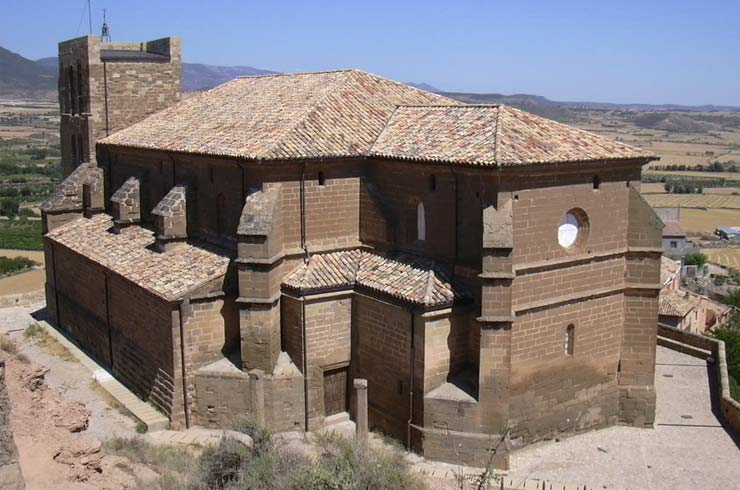
Local cuisine: flavors that complete the experience
A visit to the castle isn’t complete without tasting the flavors that define this land.
If you decide to visit Loarre Castle, we encourage you to set aside time to explore the region’s gastronomy: hearty dishes, locally sourced produce, and a cuisine that reflects the landscape and history around you.
Traditional dishes from the Hoya de Huesca
Standouts include Aragonese migas—often served with grapes, chorizo, or egg—roast ternasco (young lamb), and game stews such as rabbit or braised wild boar.
You’ll also frequently find mushroom-based dishes, especially in autumn, and recipes showcasing vegetables from local kitchen gardens.
Typical desserts and products
In villages like Ayerbe or Loarre you’ll find traditional sweets such as “tortas de alma” and “tortas de Ayerbe,” known for their fluffy texture and anise flavor.
Homemade sponge cakes, almond pastries, and treats made with honey and nuts are also common—often sold in family-run bakeries or at local fairs.
Wines and oils with character
Around Loarre you’ll come across wines from the Somontano DO and extra-virgin olive oils produced by local cooperatives.
Many restaurants and rural guesthouses feature these products on their menus or offer them for sale—savory souvenirs to take home.
Experience a guided day trip to the majestic Loarre Castle, one of Aragon’s historic gems. View Tour
A cuisine that mirrors the landscape
Traditional cooking in this part of Aragon is humble, flavorful, and sincere.
It captures the essence of the territory: the labor of the fields, adaptation to the climate, and the hospitality of its people. Dining here isn’t just about eating—it’s a way to understand the local culture.
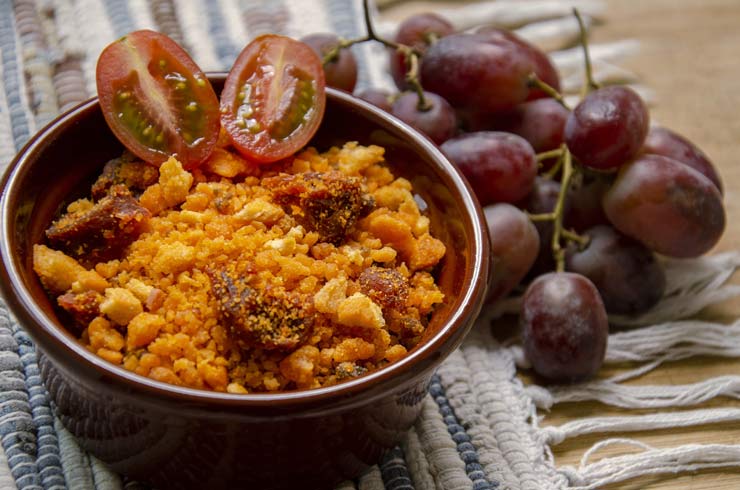
Conclusion: a fortress that leaves its mark
Visiting Loarre Castle is far more than a simple day trip.
It means peering into centuries of history, contemplating Romanesque art in its purest form, and feeling the weight of time in stones that have witnessed battles, prayers, film shoots, and legends.
Those who walk its grounds agree it’s not only about what you see—it’s about what you feel.
If you’re seeking an authentic, cultural, and deeply inspiring experience, come and visit Loarre Castle unhurriedly and with curiosity—and, if you like, with us.
At Rutica41, we’ll be delighted to accompany you on this journey to the heart of Aragon, taking care of every detail so it becomes unforgettable.
Learn more about this and other ideas in our destinations section, or contact us if you’d like to plan your next cultural and gastronomic adventure with us.

